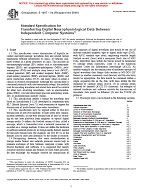1.1 This specification covers transmission of digitally recorded electrophysiologic waveform data and related textual annotations between laboratories or clinics, or between computer systems in a given laboratory or clinic. This includes all electroneurophysiology (EN) studies such as electroencephalograms (EEG) and magnetoencephalograms (MEG), polysomnograms (PSG) and multiple sleep latency tests (MSLT), evoked potentials (EP) and evoked magnetic fields (EMF), event-related potentials (ERP), electromyograms (EMG) and nerve conduction studies (NCS), and many others in either a clinical or research environment. Although this specification is concerned primarily with electroneurophysiology, the methods used for encoding waveform and related data would be suitable for other tests involving waveforms, such as electrocardiograms (EKG), vascular/intracranial pressure monitoring, oximetry, or gastrointestinal motility studies.
1.2 This specification defines a format for waveform data based on Specification E 1238 (developed in cooperation with HL7 (Health Industry Level 7)), with extensions to support the transmission of multichannel time-series waveforms.
1.3 This specification may be applied either to two-way transmission of data over medium- to high-speed data communication networks, or one-way transmission of data by recording on and later playback from magnetic or optical digital storage media. It defines the blocked stream of data, called a message, which is transmitted over a network connection or recorded on a storage medium. It does not define the hardware or software network protocols or storage media formats needed for message transmission (for example, see ISO 8072), or the formats used to store data internally by the sender or receiver.
1.4 Recognizing, however, that some standardization in storage media format and network protocols would help to promote exchange of data between computer systems with diverse hardware and software, it is suggested that readily available universal media and formats be used, when possible, for data exchange. An example suitable for transmission of large amounts of digital waveform data would be the use of industry-standard magnetic tape or digital audio tape (DAT), with ANSI standard tape labels, employing variable length blocked records (lines) with a maximum block size of 4092 bytes. Individual lines within the blocks would be terminated by carriage return characters, Code 13 in the American Standard Codes for Information Interchange (ASCII). As another example, for the transmission of moderate amounts of digital waveform data, floppy disks written in MS-DOS (1) format (or another commonly used directory and file structure) would be appropriate; the data would be contained within a single sequential file on the disk, with lines within the file delimited by carriage return (ASCII 13) or carriage return followed by linefeed (ASCII 10) characters. An example of network hardware and software suitable for transmission of waveform data would be Ethernet (2)and the TCP/IP (3)protocol.
NOTE: This page does not contain the complete scope (section 1.5). To see scope in it’s entirety please refer to the standard.
Product Details
- Published:
- 01/01/2000
- Number of Pages:
- 140
- File Size:
- 1 file , 2.3 MB
